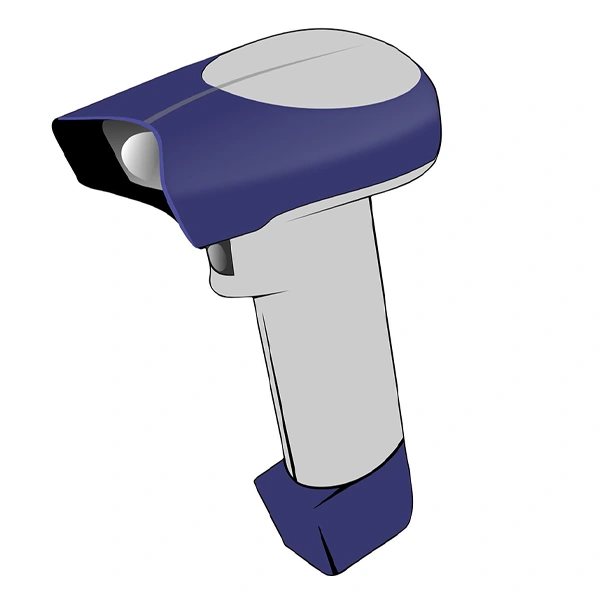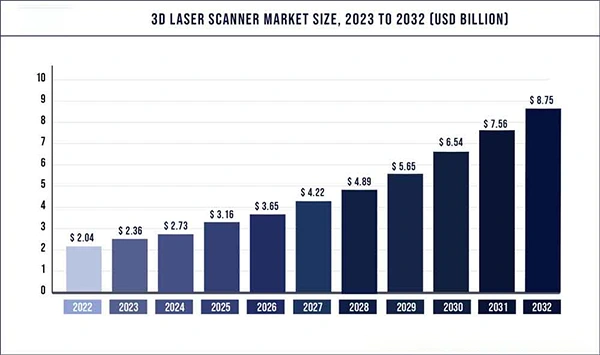
The 3D laser scanning market due to the forecasts is very likely to reach $20.87 billion, by the end of 2032.
This 3D technology is oriented towards resolving the design and production issues with the use of a scanner and copying the object.
The major reason for the change in the trend towards the scanner is that it promises a reduction in the cost of production and improved product quality.
Yes, the world is changing for the better, and every industry, whether mature or nascent, will leverage this technology in the years to come. Also, learn about Custom Software And Business Innovation by reading this article.
Therefore, allow me to take you through some of the innovative technologies that will revolutionize the future of 3D laser scanning, enhancing its precision and efficacy for various industries across the globe.
Real-time 3D scanning tools are a device that allows you to scan and proceed with data in real-time to get immediate results.
Real-time 3D scanning enables faster workflows and more interactive applications, hence, offering significant advantages over traditional 3D scanning methods.
Mobile laser scanning is a handheld device that uses laser technology to record the 3D data of objects’ surfaces.
Einstar 3D scanner is one such example of a 3D mobile laser scanner available in the market.
You may tap on this link to find an Einstar 3D scanner and leverage the power of 3D technology.
The technology of 3D laser scanning is planning to integrate AI mechanisms to enhance the abilities and capabilities of exciting or upcoming 3D laser devices.
As technology advances, AI integration will continue to enhance the efficiency, precision, and versatility of 3D laser scanning, opening new horizons in many fields.
The utilization of cloud-based procedures in 3D laser scanning will benefit the innovations to work faster and better as this approach will enable you to send 3D data to a cloud computer, providing results swiftly.
Cloud computing technologies are continuously evolving, so there are chances to see even more innovative applications of cloud-based processing in 3D laser scanning devices.

The use of Augmented Reality (AR) and Virtual Reality (VR) improves the visualization and interaction with 3D data recorded by laser scanners.
Augmented Reality (AR) and Virtual Reality (VR) revolutionize the way we interact with 3D laser scan data, thus, enabling better decision-making and streamlined workflow.
Multi-sensor integration means combining data from multiple sensors to provide a detailed and accurate 3D representation of the object or a scene.
Multi-sensor integration plays a significant role in improving the capability of 3D laser scanning systems.
Technology is evolving, and so is the demand for more precise and detailed 3D laser scanner models.
According to industry research, the demand for this technology has increased by 57%, owing to the accuracy of 3D laser scanning of buildings in the construction industry.
Further, in the medical field, the demand for fore-revolutionized and improved 3D laser scanning is increasing with a growth rate of around 15-20% per year due to its requirements in medical imaging, surgical planning, and prosthetics, and for more accurate diagnoses and treatments.
Likewise, sectors like heritage preservation are too expecting to see more growth in 3D scanning technology to accurately perceive surroundings.
Do You Know?
The first 3D laser scanning technology was developed in the 1960s and used lights, cameras, and projectors to scan objects.
The multi-platform compatibility in 3D laser scanning devices allows them to work or connect with different devices and software.
This approach enables the users to transfer or share the 3D scan data with another device like their smartphones or tablets.
Drones and aerial scanning can be used in conjunction with 3D laser scanners to create highly accurate and detailed 3D models of large areas.
Such as preparing a map of big areas – accurately analyzing the measurements, inspecting buildings if they are damaged or tilted, discovering lost people and animals, and so on.
With Advanced data analytics features, you can better understand the data you recorded when scanning the objects using a 3D laser scanning device.
The feature can look for different patterns or shapes, can measure things accurately, can compare the models, and analyze future outcomes.
3D Laser Scanning has a very significant role in Non-Destructive Testing.
It provides accurate and detailed information about the surface of an object without damaging it.
This way it helps inspectors to inspect the problem early and make sure the things are safe and working well.
In automated quality control, 3D laser scanning has its application in the verification of products.
It quickly and accurately takes images of the objects and measures each of them against the computerized picture with Anti-ips which makes sure that no slight detail goes missing.
Such technology enables companies to promote high quality on their products in a fast manner since it helps in the quick assuagement of any element that does not conform to the design.
Did you know that 3D laser scanning can capture thousands to tens of thousands of data points per second, that’s what makes this technology a powerful tool for 3D printing.
It captures the shape and appearance of the object accurately using the sensors to convert it into a digital model.
This way one can preserve historical artifacts, improve product designs, and prepare custom parts.
With the help of 3D laser scanning, color scanning has improved with the delivery of enhanced and accurate color data.
This is because 3D laser scanners are capable of collecting color information with or without geometric information in a single scan and therefore align the color data with the respective 3D model.
Moreover, high-resolution color capturing in 3D laser scanners minimizes color distortion variability and makes it possible to obtain correct color data even when lighting conditions are not optimal.
In a nutshell, peeping into the ‘crystal’ 3D laser scanning allows combining the realities of tech magic and creativity.
As this technology has come a long way, today it is a powerful and versatile tool that is used in a wide range of industries, from surveying and construction to entertainment and forensics, and we can expect to see more revolutionization and improvement that are well- integrated with technologies as AI, AR/VR, and other technologies.
